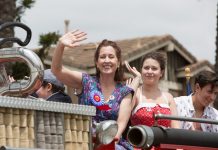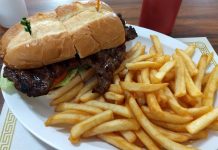By Mayor David Shawver
Well, here comes Peter Cottontail hopping down the bunny trail because Easter is on its way to Stanton.
Our town’s annual Easter egg hunt, pancake breakfast and resource fair will be held at Stanton Central Park on Saturday April 20 from 9 a.m. to 11 a.m.
All egg hunts will begin at 10 a.m. Candy-filled eggs will be hidden throughout the egg hunt areas. The age group sections will be 0-2 years, 3-4 years, 5-7 years, 8-10 years and11-13 years.
Registration is not required so just show up and be ready for a fun-filled morning. Remember to bring a container, bag or basket for egg hunt goodies.
If participants are lucky and find a “GOLDEN EGG,” they will receive a special prize. The Easter Bunny will pay us a special visit and will be available for pictures for everyone. Parents, please bring your cameras. The Pancake Breakfast is $3.50 and benefits the Stanton Youth Assistance Foundation.
Stanton just keeps on ticking like the energizer bunny when it comes to family fun. In addition to this exciting event, be sure to check out the Christmas Tree Lighting Ceremony with Santa Claus and Halloween Family and Fun celebrations coming in the future.
If you have ever wondered why we decorate eggs at Easter, let me try to explain.
Poultry eggs have been a human food for as long as humans could find eggs in a bird’s nest. It wasn’t long thereafter, in a time of no refrigeration, that people realized eggs don’t keep very well. One way to lengthen the safety of eggs is to hard boil them. Bird eggs have also long been a symbol of fertility, rebirth and the beginning of life.
As Christianity grew in Western Europe, the Catholic Church adapted many pagan customs. The egg, already long a symbol of new life, came to represent the Resurrection. Some Christians also regarded the egg as a symbol for the stone being rolled from the sepulcher. For the most part, the use of painted and decorated Easter eggs was first recorded in the 13th century.
During Lent and Passover, eating eggs was forbidden, so hard boiling or pickling the eggs were ways to preserve them. So, if for a week, you can’t eat the eggs your chickens are laying, what do you do with them after hard boiling or pickling them? Given the symbolism already established, people began to decorate the eggs.
Chocolate Easter eggs were first made in Europe in the early 19th century in France and Germany. Early eggs were solid, until the technique for mass-producing molded chocolate was invented.
Chocolate eggs (and, of course, chocolate bunnies) have become very popular with children in western cultures. And of course, Cadbury makes creme-filled chocolate eggs.
The 17th and 18th centuries saw the manufacture of egg-shaped toys, which were given to children at Easter. The Victorians had cardboard, plush and satin covered eggs filled with Easter gifts and chocolates.
And by the 1970s, colorful plastic eggs became popular for obvious reasons: they cannot spoil, do not break easily and are favorites with children.
Everyone would naturally rather have a candy-filled egg. Plastic, candy-filled eggs are commonly used in most communities.
Children were taught to prepare nests for the Easter Bunny, who would lay colorful eggs during the night provided the children were well behaved. The eggs were typically dyed by simmering them in water with onion skins, which imparted a reddish-brown color. Additional colors were achieved with madder root, walnut hulls, hickory bark and other materials. Most of the eggs were eaten over the holiday. The extra decorated eggs were often exchanged as gifts.
Egg hunting was an important game in which Easter eggs are hidden for children to find. Real hard-boiled eggs, which are typically dyed or painted, artificial eggs made of plastic filled with chocolate or candies, or foil-wrapped egg-shaped chocolates of various sizes are hidden in various places. The game is often played outdoors but can also be played indoors. The children typically collect the eggs in a basket. When the hunt is over, prizes may be given out for various achievements, such as the largest number of eggs collected. Eggs are placed with varying degree of concealment to accommodate children of varying ages and development levels. In many folk traditions it was customary to add extra obstacles to the game by placing them into hard-to reach places.
Finally, what is Easter without a major event?
The Easter parade is an American cultural event consisting of a festive strolling procession on Easter Sunday. Typically, it is a somewhat informal and unorganized event, with or without religious significance.
Persons participating in an Easter parade traditionally dress in new and fashionable clothing, particularly ladies hats, and strive to impress others with their finery. The Easter parade is most closely associated with Fifth Avenue in New York City, but Easter parades are held in many other cities. Starting as a spontaneous event in the 1870s, the New York parade became increasingly popular into the mid-20th century. In 1947, it was estimated to draw over a 1 million people. Its popularity has declined significantly, drawing only 30,000 people in 2008.
So put on your Easter bonnet, grab a basket full of colored eggs, eat a chocolate bunny, hide eggs for your kids to find and enjoy a Happy Easter with all of your family.












